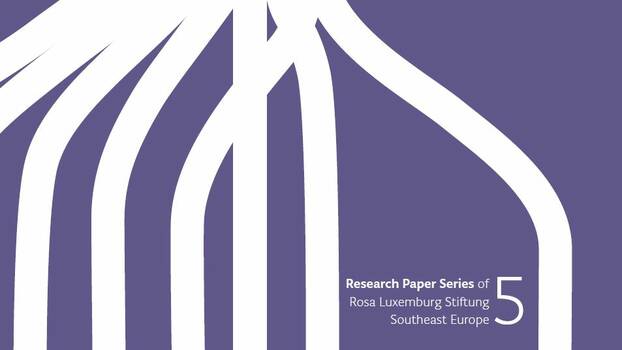
Before summer 2015, the prevailing representation of irregularized migration to the EU concerned maritime migration routes. The dominant images depicted overcrowded boats in distress and tragedies like the capsizing of a boat just off the coast of Lampedusa on 3 October 2013, when more than 300 people drowned. In summer 2015, however, the focus in the portrayal of migration shifted abruptly to the Balkan route. Media reports showed exhausted migrants walking down railway tracks through Macedonia and migrant families waiting in Belgrade parks or at the Keleti train station in Budapest. Later in the year, widely disseminated images showed migrants walking in long lines through fields or traveling on crowded trains in Croatia and Slovenia.
The Balkan route is not a new phenomenon. It has a long history, marked by successive transformations in scope and visibility. However, the unique development of a formalized corridor, established in early summer 2015, constituted an unprecedented and significant rupture in its long existence. The formalized corridor enabled refugees to cross the Balkans from northern Greece to Western Europe within two or three days, in special trains and buses (often even free of charge). They no longer needed to hire smugglers or risk their lives in dangerous circumstances, as they had to before. As this research paper will demonstrate, the formalized corridor was an example of how persistent informal migratory transit practices can result in the transformation of state and EU policies and practices. The formalized corridor came to extend up to Germany after the events of late August-early September 2015, when thousands of migrants who had been stranded at the Keleti train station started their march of hope towards Austria, resulting in Angela Merkel’s momentous decision to open the border. But several months before that, the for malization process had already started on the southern end of the Balkan route: in Serbia and Macedonia.
In the paper we first examine the different processes which contributed to Macedonia’s and Serbia’s integration into the European border regime. Those included regional and bilateral programs of economic and political aid, the EU’s involvement in resolving their internal conflicts and tensions with neighbouring countries, and the gradual incorporation of their national institutions and policies into the EU’s wider migration control agenda. The paper then analyses the countries’ respective national strategies to address the “mass transit” of migrants through the Balkans in 2015 and 2016. Those strategies reflected a constant balancing act, in which governments needed, on the one hand, to respond to the actual migratory practices and the demands of the EU, and on the other hand, to take
long-existing internal problems related to ethno-national developments in the region into consideration.
The Europeanization of migration policy within the EU and its externalization to non-EU states is broadly interpreted as result of migration becoming a security issue: “In this setting migration has been increasingly presented as a danger to public order, cultural identity, and domestic and labour market stability; it has been securitized, [resulting] from a powerful political and societal dynamic reifying migration as a force which endangers the good life in west European
societies” (Huysmans 2000: 725). But the European border regime is not only influenced by securitization, but also by humanitarianism: “Humanitarian government can be defined as the administration of human collectives in the name of a higher moral principle that sees the preservation of life and the alleviation of suffering as the highest value of action“ (Fassin 2007: 151). These two governmental logics are neither merely two sides of the same coin, nor divergent forces, as William Walters emphasizes in his article on the humanitarian border: “For instance, there are frequently occasions on which security practices and effects materialize within the institutions and practices of humanitarian government” (Walters 2011: 147). Vice versa, humanitarian logic can become a dominant dimension for security actors and practices. One example of that is the operation Mare Nostrum, which was launched in response to the above-mentioned tragedy on 3 October 2013 and has seen the Italian navy rescue more than 150.000 people from the Mediterranean Sea, who were brought to Italy. This reflection of humanitarianism in the European border regime is part of a broader trend since the 1970s of states increasingly “develop[ing] a humanitarian rhetoric and policies to describe [their] own governmental practices” (Fassin 2011: 152).
In the paper we trace how Macedonia and Serbia strategically positioned themselves regarding the government of transit migration though their territory by dynamically shifting between humanitarianism and securitization before the formalized corridor emerged, during its existence, in the process of its closure, and after it was shut down. This is not to say that precise dates can be pinpointed to distinguish these “phases”: the emergence of the formalized corridor in the south of the Balkan route, for example, was a dynamic process which resulted from the interplay of state practices, practices of mobility, activities of activists, volunteers, and NGOs, media coverage, etc. The same applies for its closure. However, the text follows a diachronic line in which we describe the contextual factors that decisively shaped the transformation of the migration policies of the two states. It focuses in particular on transportation practices, accommodation, (in)visibility of migrants, activity of (non-)state actors, unique national instruments (such as the 72-hours paper), the One Stop centres and the transit zones at the Serbian-Hungarian border.
Methodologically, the research paper follows the Ethnographic Border Regime Analysis (Tsianos and Hess 2010), meaning that we refer to written data – such as laws, official reports of national and EU institutions and NGOs, and media reports – as well as on field research, which we conducted in July-August 2016, and which included interviews with representatives of national and international (non-) governmental organizations, activists and migrants.